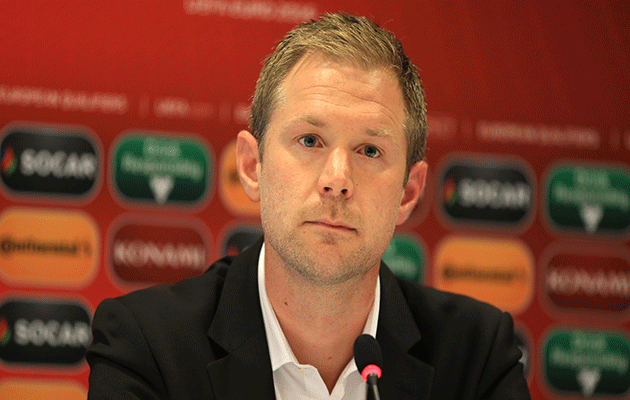Konstantin Vassiljev is hurting. “I won’t repeat what was said in the dressing room that day” he says to me, his voice almost fibrillating with subtext. I am not about to press him.
11 months ago the Estonia midfielder captained his side to a goalless draw in Seravalle, San Marino, just the third competitive match in 25 years in which Europe’s whipping boys have managed to avoid defeat. It’s the kind of prospect that must give uneasy dreams to any player before they lead their team out in international football’s most wretched dud fixture.
“Modern day football is so evenly matched. You can see in this qualifying campaign what the likes of Faroe Islands, Iceland and many others are doing” he says, but his words seem to do little to exorcise the ghosts that clearly haunt Vassiljev as the anniversary of Seravalle looms.
The only thing that would do that, you feel, would be a place in the Euro 2016 qualifying play-offs next month. There’s still a chance for Estonia and a fair one at that, but to get there they’ll need one or two results to go their way. That could well include a victory against England at Wembley on Friday.
“It’s my job to believe we can beat England,” says head coach Magnus Pehrsonn in Tallinn. “It’s a very difficult challenge but also a lovely challenge, to have to beat England and Switzerland in order to qualify.”
The Swede will lead his side out against the group’s two strongest sides over the next six days, whilst their main rivals Slovenia have the relative luxury of a game in Seravalle and then at home to Lithuania. With two points the difference between the sides, the San Marino draw feels like a bigger setback with each passing day.
“I still don’t believe we underestimated them,” Pehrsonn says in mitigation. “If you look at the game we should have won it easily with the chances we made but we just weren’t efficient enough. We had great moments, we just weren’t efficient enough to win it.
“If you look at the positive results from Euro 2012 [when Estonia reached the play-offs], we struggled to build on that at the last World Cup because we didn’t have a group of players that could continue that successful path from 2012.
“When I started we had a group of 35 players that we worked with in 2013. Since then we’ve changed maybe 50% of that group. I have four of five regulars who had no caps at all when I first started, so we really haven’t build this team around the group from 2012 at all. It’s a new generation now. Very young.”
Estonia are unusual in their approach to the regeneration of their national side in that their hand wasn’t forced by retirements or ageing legs, rather by a desire to alter their attitudes towards selection and new ways of thinking about what kind of side they wanted to be.
When Pehrsonn took the job, alongside his assistant former Derby County and Arsenal goalkeeper Mart Poom, he found himself in charge of team of players who rarely played first-team football for their clubs, if they even had clubs at all. To the Swede the idea of a national side featuring players who weren’t even training regularly let alone playing competitively was unacceptable. He talks about a “negative spiral” which had to change.
“We straight away started giving chances to players who were playing domestically and playing regularly, and when we analysed the performance data we found that these younger domestic-based players were actually performing better than the experienced players.
“And in turn we’re finding that a lot of players who were playing smaller parts at clubs abroad are now following suit and coming back to play domestically in Estonia, which has made our league here far stronger and that improves the national team. Now I’m able to invite only players who are playing regular club football to the national team which is a major change from before.”
Pehrsonn and Poom clearly have a blueprint for how a small country can seek to punch above their weight internationally. Three days before Seravalle they beat Norway 1-0 in Oslo and followed it up the same week with a win over World Cup hopefuls Jordan.
More recently Europe’s newest sensation Iceland were held 1-1 in Tallinn, leaving no room for doubt that the new look Estonia can make their presence felt at this level. Even the Dutch struggled to a draw against the minnows in the last World Cup qualifying campaign.
“There’s a very Estonian way of playing that involves being very compact, not playing too high up the pitch and waiting for our chance to counter. It means we can struggle against the likes of San Marino but it offers immense possibilities for us.
“If I look at my own philosophy, I would like to see reaction times a little quicker when we lose the ball to try and win it back, and take steps to build attacks from behind but this takes time. Right now we play the right way for Estonia.”
Estonia are the only UEFA nation to have played against all 53 of their fellow members, the reason being that the Estonian Football Association (EFA) organises five or six games a year more than anyone else on the continent. These are the kind of extra lengths that sooner or later could go some way towards elevating the team to greater recognition on the world stage.
The fear factor remains though that, however well Estonia acquit themselves at Wembley and at home against Switzerland, the damage may already have been done as far as qualification is concerned. Defeats in Lithuania and in Slovenia have left a gaping hole in their Group E record, to say nothing of Seravalle, but the fight is not gone from this team.
“Look at the Euro 2012 campaign,” urges Vassiljev. “We lost to the Faroe Islands then but still qualified for the play-offs. We really proved with that campaign that we can really play to win against all teams.”
If old nightmares are to be vanquished then the skipper may be forced to dream big. “It’s hard to play away against England of course, but anything’s possible.”
By Robert O’Connor







